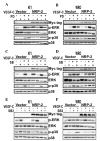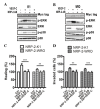Promotion of metastasis of thyroid cancer cells via NRP-2-mediated induction
- PMID: 27895796
- PMCID: PMC5104259
- DOI: 10.3892/ol.2016.5153
Promotion of metastasis of thyroid cancer cells via NRP-2-mediated induction
Abstract
Tumor-node-metastasis is one of the leading causes of morbidity and mortality in thyroid cancer patients. Upregulation of vascular endothelial growth factor-C (VEGF-C) increases the migratory ability of thyroid cancer cells to lymph nodes. Expression of neuropilin-2 (NRP-2), the co-receptor of VEGF-C, has been reported to be correlated with lymph node metastasis in human thyroid cancer. The present study investigated the role of VEGF-C/NRP-2 signaling in the regulation of metastasis of two different types of human thyroid cancer cells. The results indicated that the VEGF-C/NRP-2 axis significantly promoted the metastatic activities of papillary thyroid carcinoma cells through the activation of the mitogen-activated protein kinase (MAPK) kinase (MEK)/extracellular signal-regulated kinase and p38 MAPK signaling cascades. However, neither MEK or p38 MAPK inhibitors produced significant inhibition of the migratory activity and invasiveness regulated by the VEGF-C/NRP-2 axis in follicular thyroid carcinoma cells. Finally, VEGF-C/NRP-2-mediated invasion and migration of thyroid cancer cells required the expression of NRP-2. The present results demonstrate that the promotion of metastasis by VEGF-C is mainly due to the upregulation of NRP-2 in thyroid cancer cells, and this metastatic activity regulated by the VEGF-C/NRP-2 axis provides further insight into the process of tumor metastasis.
Keywords: NRP-2; VEGF-C; lymphangiogenesis; thyroid cancer; tumor metastasis.
Figures





References
LinkOut - more resources
Full Text Sources
Other Literature Sources
Miscellaneous
